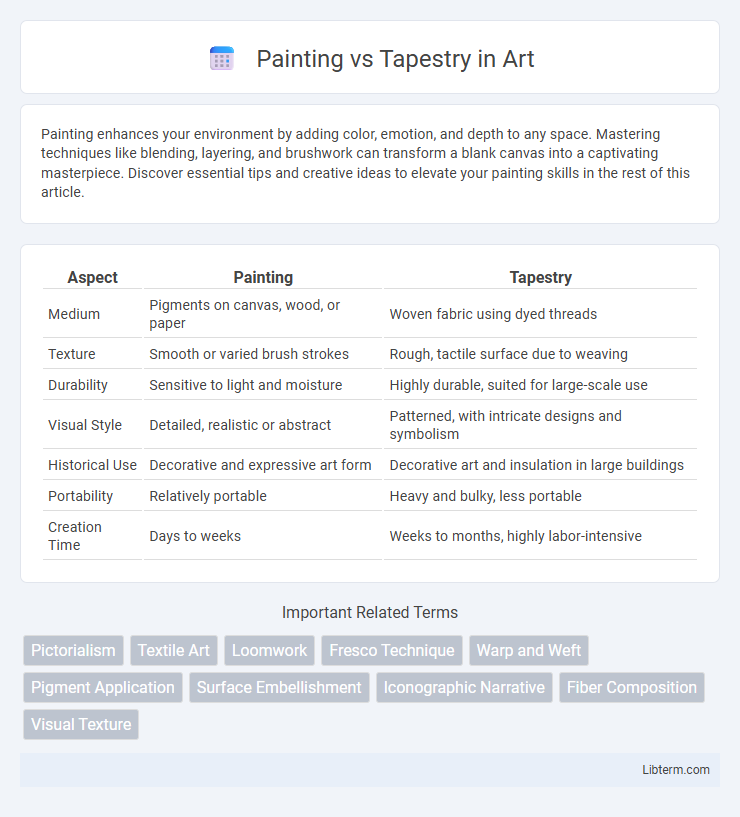Painting enhances your environment by adding color, emotion, and depth to any space. Mastering techniques like blending, layering, and brushwork can transform a blank canvas into a captivating masterpiece. Discover essential tips and creative ideas to elevate your painting skills in the rest of this article.
Table of Comparison
| Aspect | Painting | Tapestry |
|---|---|---|
| Medium | Pigments on canvas, wood, or paper | Woven fabric using dyed threads |
| Texture | Smooth or varied brush strokes | Rough, tactile surface due to weaving |
| Durability | Sensitive to light and moisture | Highly durable, suited for large-scale use |
| Visual Style | Detailed, realistic or abstract | Patterned, with intricate designs and symbolism |
| Historical Use | Decorative and expressive art form | Decorative art and insulation in large buildings |
| Portability | Relatively portable | Heavy and bulky, less portable |
| Creation Time | Days to weeks | Weeks to months, highly labor-intensive |
Introduction to Painting and Tapestry
Painting, an ancient art form, involves applying pigments to surfaces like canvas or wood to create images that capture emotions, scenes, or abstract concepts. Tapestry, a textile art, uses weaving techniques to interlace colored threads into fabric, producing intricate, durable designs often depicting historical or mythological narratives. Both mediums serve as powerful storytelling tools, distinguished by their materials and methods, shaping visual culture across centuries.
Historical Evolution of Painting and Tapestry
Painting evolved from prehistoric cave art to Renaissance masterpieces, reflecting cultural and technological advancements through mediums like oil and acrylic on canvas. Tapestry, originating in the Middle Ages, served both decorative and functional purposes, depicting intricate narratives woven from wool and silk that illustrated historical events and myths. Both art forms adapted over centuries, influencing interior aesthetics and preserving historical storytelling through visual craftsmanship.
Techniques and Materials Used
Painting techniques often utilize pigments mixed with oils, acrylics, or watercolors applied on canvas, wood, or paper, allowing for detailed brushwork and varied textures through layering and glazing. Tapestry creation involves weaving colored threads of wool, silk, or cotton on a loom, producing intricate patterns and images with a tactile, textured surface that integrates color directly into the fabric. The physical processes differ significantly, with painting focusing on surface application of color and tapestry emphasizing interlacing fibers to form durable, textile artworks.
Artistic Styles and Visual Impact
Painting offers dynamic artistic styles ranging from realism to abstract expressionism, allowing artists to manipulate color, texture, and light on a flat surface for striking visual impact. Tapestry combines textile techniques with intricate patterns, often depicting historical or mythological scenes, creating a tactile, three-dimensional effect that enhances spatial depth and richness. Both mediums engage viewers differently: paintings captivate through vivid imagery and emotional intensity, while tapestries invite appreciation of craftsmanship and structural complexity.
Symbolism and Storytelling
Painting employs brushstrokes and color gradients to convey symbolism, often using visual metaphors and allegories to represent complex themes within a single frame. Tapestry integrates intricate weaving techniques to create rich, textured narratives that unfold across expansive surfaces, allowing for detailed storytelling spanning multiple scenes. Both art forms harness symbolic imagery, but tapestries traditionally serve as immersive, multi-dimensional storytelling mediums in historical and cultural contexts.
Durability and Conservation
Paintings, especially those on canvas, often require controlled environmental conditions to prevent deterioration from light exposure, humidity, and temperature fluctuations, making their conservation efforts critical. Tapestries, woven from durable fibers like wool and silk, exhibit greater resilience to physical wear but remain vulnerable to fading and fiber degradation without proper care. Conservation of both media demands specialized techniques, with tapestries often benefiting from gentle cleaning and stable display environments to preserve their intricate details over centuries.
Cultural and Social Significance
Painting often serves as a direct reflection of individual expression and historical moments, influencing cultural identity through visual storytelling and symbolic imagery. Tapestry, with its woven texture and grand scale, traditionally signifies social status and communal values, often depicting mythological or historical narratives that reinforce collective memory. Both art forms function as powerful mediums for cultural communication, shaping societal values and preserving heritage across generations.
Economic Value and Collecting
Paintings typically hold higher economic value due to their rarity, artist attribution, and market demand, with masterpieces often commanding millions at auction. Tapestries, while historically significant and luxurious, tend to have more niche collecting markets and fluctuate in value based on condition, provenance, and age. Collectors prioritize paintings for investment and prestige, whereas tapestries attract those interested in historical craftsmanship and interior decor.
Display and Installation Differences
Paintings typically require wall mounting using hooks or frames, allowing for straightforward installation and prime visibility in well-lit areas. Tapestries demand a more robust support system such as rods or specialized hanging hardware to distribute weight evenly and prevent fabric distortion. Unlike paintings, tapestries can also be draped or suspended from ceilings, offering versatile display options that adapt to various architectural spaces.
Choosing Between Painting and Tapestry
Choosing between painting and tapestry depends on the desired texture, durability, and aesthetic impact in a space. Paintings offer vibrant colors and detailed visuals suited for personal expression and fine art collections, while tapestries provide rich textures and insulation benefits, enhancing room acoustics and warmth. Consider the environment and maintenance preferences to determine whether a painting's visual intensity or a tapestry's tactile presence better complements the interior design.
Painting Infographic

 libterm.com
libterm.com